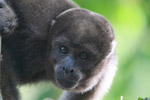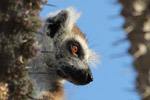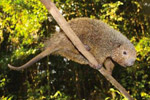New research refutes previous findings
Barbed-wire snares, spent shotgun shells, the lingering smell of gunpowder, and strips of curing meat: glimpses from a bushmeat hunt. Bushmeat hunting is the illegal hunting of wildlife for food and income. A newly released study in mongabay.com’s journal Tropical Conservation Science reports regular bushmeat consumption by a large proportion of Tanzania’s tribal populations. Co-authors Silvia Ceppi and Martin Nielson were hunting for their own answers: who was eating bushmeat and why?
Unregulated hunting, as well as land conversion, has led to dwindling wildlife populations and is posing a serious threat to biodiversity in this East African nation. However, bushmeat also plays an important role as a protein and income source for locals. According to Ceppi and Nielson, “illegal hunting may be the only way for local communities to benefit from adjacent wildlife reserves.”

Bushmeat for sale in Laos. Photo by Rhett A. Butler.
To get at the driving forces behind bushmeat consumption, Ceppi and Nielson took a broad look across three hundred households of ten tribes living in biodiverse ecosystems throughout Tanzania. Ceppi interviewed men, women and teenagers in each tribe, traveling to remote areas across the country between 2007 and 2009. Having a hunter in the household greatly increased the frequency of bushmeat consumption, suggesting that in these tribal areas the sale of bushmeat is limited. Ease of access to wildlife was key: hunting levels dropped off in highly protected areas, as well as with increasing distance to the reserves.
Several previous studies on bushmeat consumption in Tanzania suggest that ownership of domesticated animals reduces the pressure on nearby wildlife. Contrary to these findings, Ceppi and Nielson found patterns of livestock holding and bushmeat consumption aligned more with cultural patterns: tribes rearing cattle and sheep consumed less, whilst those holding pigs and poultry tended to eat bushmeat more regularly. While cattle-herding Maasai were uninterested in bushmeat, nearly all respondents of farming groups such as the Wanguu regularly included bushmeat in their diets. Some tribes even have special cultural meanings attached to eating bushmeat; the Wataturu, for example, consider elephant trunks to increase male virility.

The term “bushmeat” is a catch-all category that include common species as well as those that are threatened. Photo by Rhett A. Butler.
As always, however, the devil is in the details. The broadly defined concept of bushmeat is a colonial-era construct, originating with a set of restrictions on wildlife hunting enacted by the German colonial administration in the early 1900s.
“These laws were tightened by the British government in 1918, when a visible reduction of wildlife populations became a concern,” Ceppi said. Bushmeat laws were created to preserve colonial interests and resources in the face of pressure from indigenous populations.
Furthermore, the usefulness of the term “bushmeat” is questionable, as hunting of abundant wild species such as hare (Lepus capensis) and cane rat (Thryonomys swindernianus) is equated with the hunting of IUCN-listed vulnerable species such as elephant (Loxodonta africana) and hippopotamus (Hippopotamus amphibius). This old-fashioned, broad-strokes approach obscures important components of the biodiversity in question.
Ceppi and Nielson emphasized two key takeaways from their study. The prevailing assumption that bushmeat hunting could be ameliorated through provision of domesticated animals and alternate protein sources is not the simple solution policy makers have hoped for. Secondly, bushmeat regulation needs to carefully consider cultural variation, taking into account a holistic view of local people’s habits on biodiversity impacts.
Citation:
- Ceppi, S. L. and Nielsen, M. R. 2014. A comparative study on bushmeat consumption patterns in ten tribes in Tanzania Tropical Conservation Science Vol.7 (2): 272-287.
Related articles
Indonesia’s forests increasingly empty of wildlife(05/25/2014) Tropical rainforests are the most species-rich ecosystems in the world. Each square kilometer has hundreds of tree species, birds and mammals, and countless other creatures. The idea that these forests could be devoid of animal life therefore seems ludicrous. Still the disappearance of birds, mammals and other species is what is happening in Indonesian forests. The ’empty forest’ syndrome is becoming an increasing reality in this country.
Next big idea in forest conservation? Linking public health and environmental degradation

(05/22/2014) Dr. Christopher Golden is an explorer on a mission. As both an epidemiologist and ecologist, he is investigating and expanding the interface between human and ecosystem health. This year, Golden was appointed the Director of Wildlife Conservation Society’s HEAL (Health & Ecosystems: Analysis of Linkages) Program.
Small monkeys take over when big primates have been hunted out in the Amazon

(04/21/2014) The barbecued leg of a spider monkey might not be your idea of a sumptuous dinner, but to the Matsés or one of the fifteen tribes in voluntary isolation in Peru, it is the result of a successful hunt and a proud moment for the hunter’s family. However, a spider monkey tends to have only a single infant once every 30 months, which necessarily limits the number of adult monkeys available to subsistence hunters.
Over 9,000 primates killed for single bushmeat market in West Africa every year

(03/24/2014) Over the past 25 years, West Africa’s primates have been put at risk due to an escalating bushmeat trade compounded with forest loss from expanding human populations. In fact, many endemic primates in the Upper Guinea forests of Liberia and Ivory Coast have been pushed to the verge of extinction. To better understand what’s happening, a recent study in mongabay.com’s open-access journal Tropical Conservation Science investigated the bushmeat exchange between these neighboring countries.
Islamic clerics issue ‘fatwa’ against poaching, declare the illegal wildlife trade ‘haram’

(03/10/2014) Indonesia’s Islamic clerics drew praise from conservation groups last week after the top clerical body in the world’s largest Muslim-majority country issued a fatwa, or religious decree, against poaching and wildlife trafficking. The Indonesian Council of Ulema (MUI) announced the fatwa on Tuesday, declaring the illegal wildlife trade to be haram, or forbidden under Islamic law. The fatwa forbids Indonesia’s Muslims from “all activities resulting in wildlife extinction” and is meant in part to help support existing national laws protecting endangered species, which are poorly enforced and have done little to prevent poaching.
The smoothtooth blacktip shark and four other species rediscovered in markets

(01/21/2014) Scientific American) magazine recently ran an article on the rediscovery of the smoothtooth blacktip shark (Carcharhinus leiodon) in a Kuwaiti fish market. Believed extinct for over 100 years, the smoothtooth had not been seen since the naturalist Wilhelm Hein returned from a trip to Yemen in 1902. With its reappearance, scientists scoured Kuwaiti markets and discovered an astounding 47 individual smoothtooth blacktips.
Lions face extinction in West Africa: less than 250 survive

(01/08/2014) The lions of West Africa, which may represent a distinct subspecies, are on the precipice of extinction. A sober new study in PLOS ONE reports that less than 250 mature lions survive in the region. Scientists have long known that West Africa’s lions were in trouble, but no one expected the situation to be as dire as it was. In fact, in 2012 scientists estimated the population at over 500. But looking at 21 parks, scientists were shocked to find lions persisted in just four with only one population containing more than 50 individuals.
Madagascar’s most famous lemur facing big threats

(12/18/2013) The ring-tailed lemur (Lemur catta), perhaps the most well-known of Madagascar’s endemic animals, is facing a “very high” risk of extinction in the wild. The Madagascar Section of the IUCN Primate Specialist Group reassessed the Red List status of ring-tailed lemurs and upgraded the species from Near-Threatened (2008) to Endangered (2012). Ring-tailed lemurs are facing extinction in some parts of Madagascar because of continued habitat loss, and more recently, species exploitation.
Odd porcupine hugely imperiled by hunting, deforestation

(12/16/2013) The thin-spined porcupine, also known as the bristle-spined rat, is a truly distinct animal: a sort of cross between New World porcupines and spiny rats with genetic research showing it is slightly closer to the former rather than the latter. But the thin-spined porcupine (Chaetomys subspinosus), found only in Brazil’s Atlantic Forest, is imperiled by human activities. In fact, a new study in mongabay.com’s open access journal Tropical Conservation Science found that the species remains a target for hunters, despite a reputation for tasting terrible.